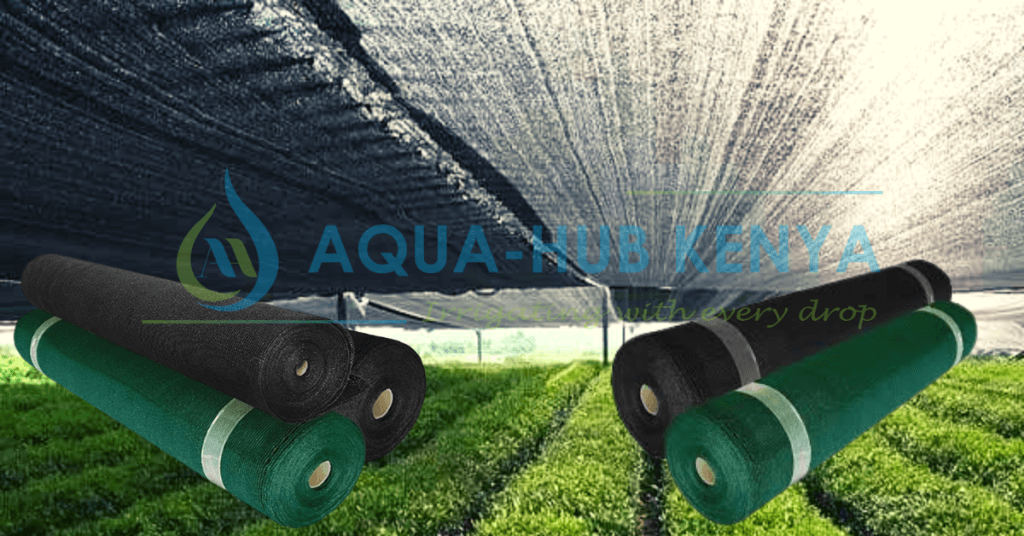Shade Net Prices in Kenya

Shade Net Prices in Kenya vary according to the length and shade rate filtering needed. For a 4M*50M shade net, prices can range from Ksh 13,000 to Ksh 30,000. Our nets are applicable in greenhouses for ornamental horticulture, coffee seedling nurturing, and under certain circumstances, vegetable production. They offer 30%–90% shade. Between those with 30% filtration and those with 90% filtration, there are differences in the price and cost of shade nets in Kenya. The cost of our shade net, which is 4M*50M, rises as the rate of filtration does.
What are shade net prices in Kenya?
In most cases, shade net prices in Kenya can vary greatly, ranging from KES 150 to KES 500 per square meter. Several factors influence the price, such as the quality of the material, size, and manufacturer. Some companies offer lower prices for bulk purchases, while others have premium prices for high-quality products. Supply and demand also market price, as well as import and export regulations.
Our pricing, however, are as follows: Ksh. 70 per square meter for 35% shading, Ksh. 85 for 55% shading, Ksh. 105 for 75% shading, and Ksh. 160 for 90% shading. These are the prices for different shading per square meter.
| Shade Rate (Filtration in %) | Colour | Measurements | Price per sqm in Ksh. |
| 35 % | Black & Green | 4 m x 50 m | 70/- |
| 55% | Black & Green | 4 m x 50 m | 85/- |
| 75% | Black & Green | 4 m x 50 m | 105/- |
| 90% | Black & Green | 4 m x 50 m | 160/- |
We can also sale the whole net which is usually 4mtrs (width) by 50mtrs (length). The prices are as follows, depending on different shading of the shade nets.
| Shade rate (Filtration rate %) | Length (meters) | Price (KSH) |
| 35% | 4 x 50 | 13,000 |
| 55% | 4 x 50 | 16,000 |
| 75% | 4 x 50 | 19,000 |
| 90% | 4 x 50 | 30,000 |
Shade net price and cost depending on farm size are also available in Kenya. Most of the time, we offer prices for various shade net filtration rates per acre.
| Filtration rate % | Color | Cost per Acre (Ksh) |
| 35% | Black & Green | 295,000 |
| 55% | Black & Green | 352,500 |
| 75% | Black & Green | 410,200 |
| 90% | Black & Green | 696,500 |
What are the uses of shade nets in Kenya?
Shade nets are widely applicable in Kenya for a variety of purposes, including:

- Agricultural purposes: Shade nets are applicable in greenhouses to protect crops from excessive sunlight and heat. They also help regulate temperature and humidity levels, improving crop growth and yields.
- Livestock protection: Shade nets also provide shade for livestock, reducing heat stress and improving their comfort and health.
- Residential shading: Shade nets are also applicable in residential areas to provide shade for homes, patios, and other outdoor spaces, reducing the amount of direct sunlight and improving comfort levels.
- Commercial shading: Shade nets are used in commercial areas, such as parking lots and public spaces, to provide shade and reduce the amount of direct sunlight, improving comfort levels and reducing the risk of skin damage.
- Sport shading: Shade nets are also applicable in sporting facilities, such as tennis courts and soccer fields, to provide shade and reduce the amount of direct sunlight, improving the playing conditions and reducing the risk of skin damage.
These are the most common uses of shade nets in Kenya, but they can also be used for a variety of other purposes.
What are the importance of shade nets in Kenya?
Shade nets play an important role in Kenya, providing various benefits in various industries, including:

- Agriculture: By providing a controlled environment for crops, shade nets help to improve the growth and yields of crops, reduce the risk of disease and pests, and increase the quality of produce.
- Livestock protection: By providing shade for livestock, shade nets help to reduce heat stress and improve the health and comfort of animals, leading to increased productivity and profitability for farmers.
- Residential and commercial shading: By reducing the amount of direct sunlight, shade nets help to improve comfort levels and reduce the risk of skin damage, making outdoor spaces more usable and enjoyable.
- Sports and recreation: By reducing the amount of direct sunlight, shade nets help to improve playing conditions and reduce the risk of skin damage, making sports and recreational facilities safer and more enjoyable.
- Environmental protection: By reducing the need for air conditioning and other cooling systems, shade nets help to reduce energy consumption and greenhouse gas emissions, making them an environmentally-friendly solution.
Overall, shade nets play a crucial role in Kenya by improving comfort levels, reducing heat stress, and providing protection from the harmful effects of excessive sunlight.
What are the features of shade nets?
The features of shade nets vary depending on the manufacturer and quality, but some common features include:
- UV protection: Most shade nets are treated to provide protection from harmful UV rays, making them a safer solution for outdoor shading.
- Durability: Shade nets are typically made from high-quality, long-lasting materials, such as polyethylene, to ensure they can withstand exposure to the elements.
- Light transmission: The amount of light that passes through a shade net can be adjusted depending on the specific needs, with some shade nets allowing more light to pass through while others block more light.
- Strength: Shade nets are designed to be strong and durable, with high-quality products able to withstand wind and other weather conditions.
- Easy installation: Shade nets are typically designed for easy installation, with many products coming with all the necessary hardware and instructions for quick and straightforward setup.
- Customization: Shade nets can be customized to fit specific needs and requirements, with a range of sizes, colors, and other options available.
- Cost-effective: Shade nets are a cost-effective solution for shading, providing an affordable alternative to traditional shading options such as awnings and pergolas.

These are some of the most common features of shade nets, but specific products may have additional features depending on the manufacturer and quality.
Which plants are grown under shade net?
- Vegetables: Crops such as lettuce, spinach, kale, and Swiss chard are commonly grown under shade nets due to their preference for cooler, shadier conditions.
- Herbs: Herbs such as basil, cilantro, and parsley can also be grown under shade nets, as they typically do not require full sun exposure.
- Flowers: Some flower crops, such as orchids and ferns, are often grown under shade nets to provide protection from direct sunlight and heat.
- Fruits: Some fruits, such as strawberries and blueberries, can be grown under shade nets to provide protection from excessive sunlight and heat.
- Spices: Shade nets can also be used to grow spice crops, such as turmeric, ginger, and cardamom, which typically require cooler growing conditions.
These are some of the most common plants that can be grown under shade nets, but many other species can also be grown in this environment, depending on the specific needs and requirements of the plants.
Aqua Hub Kenya is a well-known provider, dealer, and installer of shade nets. Green and black shade netting is available. We have offices in both Nairobi and Eldoret. We are a reliable provider of agricultural products and management services. For more information, please call 0790719020.






